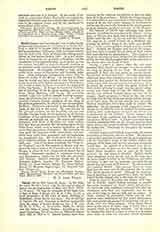

David, GHEERAERT (or GERARD), son of John David, painter and illuminator, b. at Oudewater, South Holland, c. 1450, d. August 13, 1523, at Bruges, where he had been admitted, January 14, 1484, as master-painter into the Guild of St. Luke, of which, after filling minor offices, he was elected dean in 1501. It is not known where he learned his art, probably at Haarlem. On the completion of his apprenticeship, he no doubt, as was the custom, travelled to improve himself, working as an assistant under various masters wherever he found employment. He probably travelled to Italy, as his works show traces of Florentine and Venetian influence. Their landscape backgrounds prove that he knew the valley of the Meuse. On his way to Flanders he would not have failed to visit Louvain and study the works of his fellow-countryman, Dirk Bouts, nor to halt a while at Ghent to admire the polyptych of the Van Eycks. At Bruges he found the churches full of paintings by all the great masters, and one of these, Hans Memling, still living. He probably worked under him until he himself received commissions, for which he had not long to wait. In 1496 he married Cornelia Cnoop, daughter of the dean of the guild of goldsmiths, by whom he had one daughter, Barbara. Gheeraert was buried in the church of Our Lady, at the foot of the tower. He was not one of the greatest masters, nor did he strike out any new line like Van der Goes, but he gathered up all the best traditions of his predecessors, to which he faithfully adhered all through his life. His saints and angels compared with those of Memling are more sedate. One new type he created, the charming figure of the Child Jesus, which made a lasting impression on the succeeding generation of painters. His portraits are very good, his brocaded stuffs, embroidery, and jewelry have never been surpassed, and his landscapes are remarkably fine. His works show that he was a great religious painter; he was also a pious and charitable man. One of his finest paintings, the “Virgo inter Virgines”, now in the museum at Rouen, was presented by him in 1509 to the Carmelite nuns of Sion at Bruges, to whom he lent a large sum of money free of interest. Gheeraert excelled in miniature-painting and illumination, which arts his wife also practiced with success. David’s principal works are in the National Gallery, London (2), National Gallery, Dublin (I), Town Gallery, Bruges (5), Town Gallery, Rouen (I), Museum, Sigmaringen (2), Imperial Gallery, Vienna (I).
W. H. JAMES WEALE

